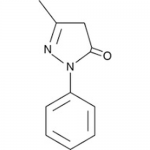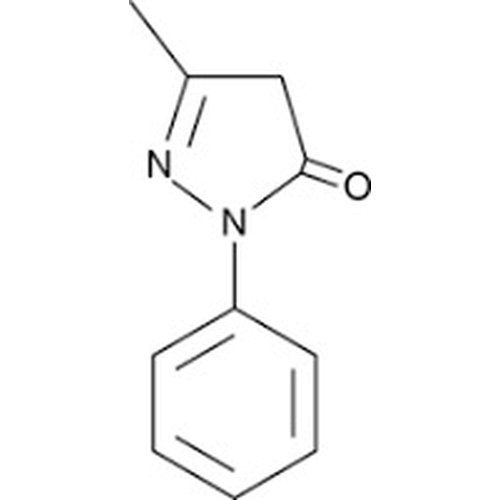| Product Name | Edaravone |
| Description |
Free radical scavenger |
| Purity | >98% |
| CAS No. | 89-25-8 |
| Molecular Formula | C10H10N2O |
| Molecular Weight | 174.2 |
| Field of Use | Not for use in humans. Not for use in diagnostics or therapeutics. For in vitro research use only. |
Properties
| Storage Temperature | -20ºC |
| Shipping Temperature | Shipped Ambient |
| Product Type | Antioxidant |
| Solubility | Soluble to 100 mM in DMSO |
| Source | Synthetic |
| Appearance | Light Yellow Solid |
| SMILES | CC1=NN(C(=O)C1)C2=CC=CC=C2 |
| InChI | InChI=1S/C10H10N2O/c1-8-7-10(13)12(11-8)9-5-3-2-4-6-9/h2-6H,7H2,1H3 |
| InChIKey | QELUYTUMUWHWMC-UHFFFAOYSA-N |
| Safety Phrases |
Classification: Harmful. May be harmful if inhaled, swallowed or absorbed through skin. Safety Phrases: S22 - Do not breathe dust S24/25 - Avoid contact with skin and eyes S36/37/39 - Wear suitable protective clothing, gloves and eye/face protection Risk Phrases: R20/21/22 - Harmful by inhalation, in contact with skin and if swallowed R62 - Possible risk of impaired fertility R68 - Possible risk of irreversible effects Hazard Phrases: H302-H315-H319-H335 Precautionary Phrases: P261-P305 + P351 + P338 |
| Cite This Product | Edaravone (StressMarq Biosciences Inc., Victoria BC CANADA, Catalog # SIH-152) |
Biological Description
| Alternative Names | 5-Methyl-2-phenyl-2,4-dihydro-3H-pyrazol-3-one, MCI-186 |
| Research Areas | Cancer, Oxidative Stress |
| PubChem ID | 4021 |
| Scientific Background | Edaravone is a free radical scavenger and antioxidant that has demonstrated neuroprotective effects in models of ischemic stroke and neurodegeneration. It mitigates oxidative stress by inhibiting lipid peroxidation and the lipoxygenase pathway, thereby preserving neuronal integrity. Edaravone has been shown to protect dopaminergic neurons from MPTP-induced neurotoxicity, a model of Parkinson’s disease. Its ability to cross the blood-brain barrier and reduce reactive oxygen species makes it a valuable agent in the treatment of neurodegenerative conditions characterized by oxidative damage and mitochondrial dysfunction. |
| References |
1. Kawai G., et al. (1997) J Pharmacol Exp Ther. 281(2): 921-927. 2. Yuki S., and Koqure K. (1997) Mol Chem Neuropathol. 32(1-3): 123-128. |



Reviews
There are no reviews yet.